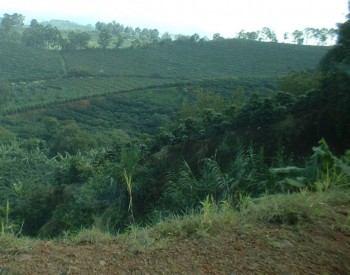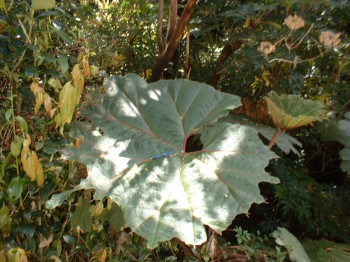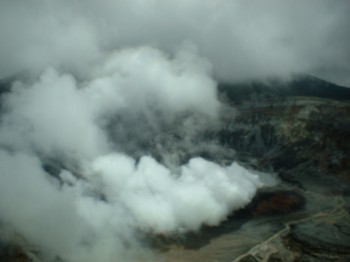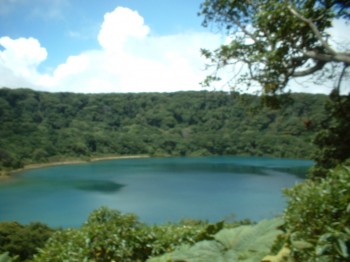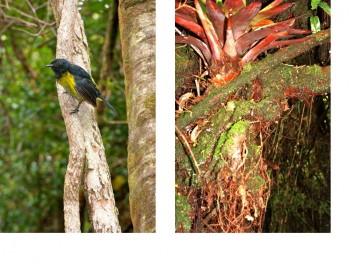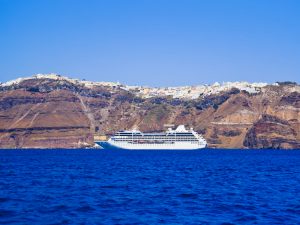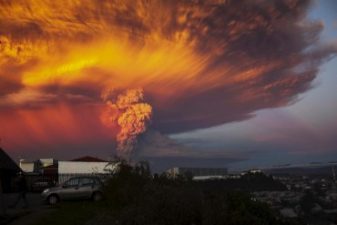Dr. Gotlieb describes a recent trip to his birthplace: Costa Rica
Alajuela Province, July 22, 2010: For a Costa Rican-born Israeli geographer, a 36-hour lightning visit for a family event in San José afforded an opportunity to one of the most unique landscapes and ecosystems in the world.
Atop the Poas Volcano situated in one of Costa Rican’s renown national parks there are two lagoons, one in the central crater of the now-active volcano, the other, the Botos, filled to the brim with rainwater. Surrounding the area is a rare form of woodlands — a cloud forest — a natural aviary with 79 species of birds.
The day I toured the site began with my reading in La Nacion, the country’s leading daily. An article described aspects of Costa Rica’s water resources that stand in stark contrast to our situation in Israel. Like in Israel, water is a central concern in this country. However, rain forests and numerous rivers are found throughout this largely tropical land situated between the Gulf of Mexico and the Pacific Ocean, on the Central American isthmus.
As a result, unlike our parched land, Costa Rica suffers from water excesses, specifically inundations during the rainy season. On the day before my arrival, more than 20 houses were washed away by rain-swollen rivers in the Central Valley, where the capital San José is located.
Diverse Eco-Zones
Costa Rica, like Israel, is a small compact country and has a wealth of distinct eco-zones that can be reached within hours. My visit to the Poas Volcano began in the temperate central valley, which is bordered by a mountain range and a chain including four of the country’s seven active volcanoes. All told, Costa Rica has 212 volcanic formations.
From Escazu, an upscale borough of the capital, we drove north. The highway through the metropolitan area is jammed with vehicular traffic and lined with savannah; grasses grow a meter tall or higher. Deep ravines with rivulets can be seen from the road.
Along the way to Poas is the second of the Central Valley’s cities, Alajuela, which is a symbol of Costa Rican democracy. In 1856, the settlement held the line against an invasion by Nicaraguan mercenaries in the service of an American filibuster, William Walker, who attempted to carve out a slave empire in Central America.
The area was particularly coveted by the invaders given that along the Costa Rican-Nicaraguan border runs the San Juan River, which was sought as an alternative site to the Panama Canal. Alajuela is a small city proud of its historical significance and educational institutions. Its central park is bordered by mango trees and a sculpture of Juan Santamaría, the national hero who led the resistance against the American-backed invasion.
Coffee Lands and Huge Ferns
Alajuela is thirty kilometers from the Poas volcano. On the way to the national park we passed the town of San Isidro, named after the Catholic saint of land and farmers.
It is an area of incredible fecundity and the locale of many of the country’s famed coffee plantations. At an elevation of one thousand meters, the terrain is ideal for coffee cultivation.
With rich volcanic soils, good drainage, sunny mornings and rain-filled afternoons that provide the six hours of daylight that is optimum for growing coffee, the crop thrives in the area. Significantly, forty percent of the coffee lands in the area are owned by one family. Migrant labor, mainly from Nicaragua to the north, is the principal labor source cultivating the crop.
Past San Isidro is a transition zone where the primary form of cultivation is horticulture, predominantly large ferns cultivated under the shade of expansive black netting. The produce is exported to North American and European markets for use in flower arrangements. Hibiscus flowers are abundant, as is a range of other flora.
Further north is grazing land for dairy cows. The embankments at the side of the road tower up to ten meters revealing deep, brown soils. The roots of a typical tree are often the size of a log. The houses along the hillsides are painted mauve, lime, blue and guava — tropical colored adobes amidst the verdant green. North American hippies in search of tranquility found their way here in the 1970s and signs leading to enterprises like Muy Tranquillo Regalos (“Very Tranquil Gifts”) and the La Paz Peace Lodge line the road.
Poas Volcano National Park
Founded on January 25, 1971 the Poas Volcano National Park is 2708 meters above sea level and encompasses 6,500 hectares. It has two craters, the Central Crater being the site of an active volcano and the Botos Crater crowning a volcano that has been extinct for thousands of years.
I was warned that there might be poor visibility due to the rains experienced earlier in the week and that were expected to continue. Thankfully the skies held, and the site is well-planned and cared for by the authorities.
The Central Crater: Power and Plumes
The passageway to the volcano is a ten minute walk fringed with large trees and ferns the size of elephant ears. The pungent odor of sulphur becomes apparent when, suddenly, the tree line ends and one arrives at a wooden observation post. Before you is a sight that is difficult to anticipate, a world unlike any other.
The vast landscape is denuded of vegetation. Sheer rock in various shades of brown, gray and red line the sides of a huge crater of the Poas Volcano that is very much active. Clouds hover overhead and a jet of vapor and steam pumps from the bowels of the earth. It is raw nature, the source of power that can and has ejected boulders, lava and ash within recent memory (1956). At present, the 1.6 kilometer wide crater emits steam and vapor, a reminder of its explosive potential, an epicenter for earthquakes.
Danger of Acid Rain
At the bottom of the crater is one of the site’s two lagoons. Due to the active heat of the volcano, the lagoon in the Central Crater is expected to become completely evaporated by December of this year, down from a depth of fourteen meters six months ago. The consequence will be acid rain, which will likely damage coffee and other crops in the adjacent slopes of the mountain. As long as the volcano is active and the heat evaporates rainwater, the threat of acid rain remains.
The Botos Lagoon
A forty minute walk from the main crater leads to the extinct Botos Crater. The basin is deep with rainwater that feeds into the Rio Angel and the Rio Sarapiqui. The site is exquisite, a natural wonder.
It is surrounded by thick forests containing scores of bird species including hummingbirds, robins and quetzals. Mammals include coyotes, long-tailed weasels, skunks and felines and a squirrel endogenous only to Poas.
Throughout the low, thick canopy and brush surrounding the Botos lagoon is a myriad of plant species that comprise a unique ecosystem in shades of dark and light.
The clouds are of central importance to Costa Rica’s watershed and water regeneration. The cloud forest atop Poas is the source of many rivers running east to the Gulf of Mexico and west to the Pacific.
A tour of the Poas Volcano National Park is breathtaking and sobering: the glory and power of nature are apparent there. The site is a monument to natural realities that no amount of technology can contain or emulate. I hope to return there, again and again, as it is a place of extreme poetry.
More travel news from afar:


